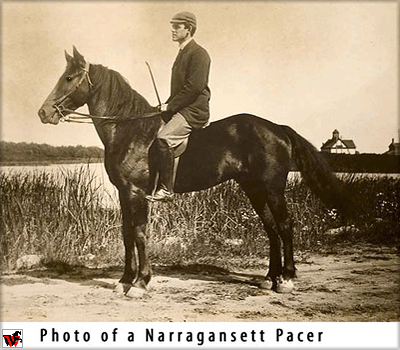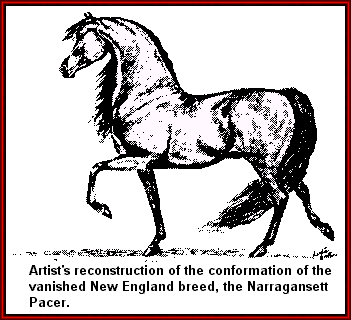|
|
|
|
 |
Predating all the
American breeds as well as the importation of Thoroughbreds to this
country was the Narragansett Pacer. It was in evidence in the US
as early as 1676, and is regarded as the base upon which all easy gaited
horses in America rests. There is much speculation over their exact
ancestry. Some historians believe they derived from the British
Hobbies and Galloways, while others believe they were derived from the
Spanish Jennet. The truth may never be known, but in addition to being
highly prized as smooth gaited saddle horses, they were also widely
raced in those areas of the Colonies where religious leaders would allow
such "dubious" sport. It is uncertain just which gaits they
actually performed, as in those times all the soft gaits were grouped
together under the terms "pace" or "amble." Exported to the West
Indies and Caribbean Islands, these horses mixed with Spanish stock, to
form many of today's Paso breeds.
The Narragansett was described as small, commonly sorrel and
distinguished by a pacing gait. They were hardy, sure of foot, and
easy moving horses. They were believed to be the result of
carefully selecting and breeding from the best and fastest descendants
of the English Pacers, that were found everywhere in the colony of
Massachusetts. The people of Rhode Island were largely made up of
refugees from the religious intolerance of the New England colonies.
They loved a good horse race, which was denied them in the other
settlements. When they moved to Rhode Island, they brought their
best horses with them. Race courses were established, valuable prizes
were offered, and improving the breed became serious business. The
blood of the Narragansett Pacer, therefore, was not different from the
blood of the pacers of the other colonies, but the development of his
speed by the establishment of the racing industry brought the best and
fastest horses to this colony and from them, they built the breed that
became famous throughout all the inhabited portions of the Western
hemisphere. The Narragansett Pacer was established as the
aristocrat among horses in the colonies.
In the case of the Narragansett horse, there was first a desire for an
easy riding and utility horse. Then came the process of selective
breeding to produce and improve this animal. Third, after some years had
passed, the horse was converted into a luxury item employed mainly for
entertainment. This pattern was held to in the case of the
Tennessee Walking horse as well. When the Narragansett Pacers were
sent back to the mainland, one of the chief areas they were imported to
was Virginia and North Carolina which in turn supplied the utility mares
brought to Middle Tennessee around 1800.
After the American Revolution, Rhode Island was no longer a frontier
settlement, but had grown into a rich and prosperous state. Mere
bridal paths through the woods had developed into broad, smooth
highways, and wheeled vehicles had taken the place of the saddle.
Under these changed conditions, the little pacer was no longer desirable
or even tolerable as a harness horse, and he was supplanted by a larger
and more stylish type of horse that was better suited to the particular
kind of work required of him.
Regardless of the reason for its disappearance, the Narragansett Pacer
had laid the foundation for the pacing horse in America, and it's
influence would carry on where ever pacing horses existed. The
little horse had served its people well. It was the horse that
carried Paul Revere on his famous ride and was the favorite mount of
George Washington.
Since the Narragansett Pacer made significant contributions to the
Walking Horse breed, its characteristics are worthy of attention.
By modern standards, the Narragansett Pacer would be classed as a scrub.
It was small: the average height of the Rhode Island horses in 1769 was
14:1 hands, which was a step up from the 1750 average of 13:2.
They were judged even at their time to be "not very handsome, but good",
plain in their form and low in their carriage. They were fleet,
hardy and docile, surefooted, but not beautiful, and it is reasonable to
suppose that the lack of style and beauty was one of the leading causes
of its becoming extinct.
|
| A further description of the Narragansett Pacer can be found in the 1830
edition of the Edinburgh Encyclopedia:
Head clean, the neck long, hocks a little crocked.. color
generally though not always, bright sorrel... very spirited and
carry both head and tail high... where the ground requires it,
they have a fine, easy single-footed trot. These circumstances,
together with their being very sure-footed, render them the finest
saddle horses in the world, as they fatigue neither themselves nor
their rider. They pace naturally.. with such swiftness and for so
long a continuance as must appear almost incredible to those who
have not experienced it. The Narragansett Pacer was able to pace a
mile under saddle in slightly over two minutes, and pace three
miles in seven minutes. |
 |
|
These horses were
ideal saddlers for more reasons than speed. They were noted for
ease of motion, which propelled the rider in a straight line without any
side-to-side or up-and-down jogging. Such comfort in the saddle
made long trips possible in the sparsely settled colonies.
Fortunately, the blood of the Narragansett Pacer was not lost when the
breed vanished from Rhode Island. It was literally banished to the
frontiers of Canada, Indiana, Missouri, Kentucky, and Tennessee, where
in 1901, the bloodlines were still appreciated and preserved for the
luxurious saddle gaits which they alone transmitted. It is not
clear whether or not these horses actually performed a true pace, as the
terms "pace" and "amble" were then used to denote most any of the soft
gaits, including the fox trot, running walk, stepping pace or rack.
Other legends describe these horses covering over a hundred miles in a
single day.
Just prior to the Civil War, the Canadian Pacers were transported to
Kentucky and Tennessee. Although the Narragansett Pacer blood had
been mixed with that of the Canadian Pacer, the gaits were still pure,
and without a doubt the American Saddlebred, the Standardbred, and the
Tennessee Walking Horse owe much of their existence to these noble
little Rhode Island horses.
|
|
|
|
|
|
|
|
|
|
|
